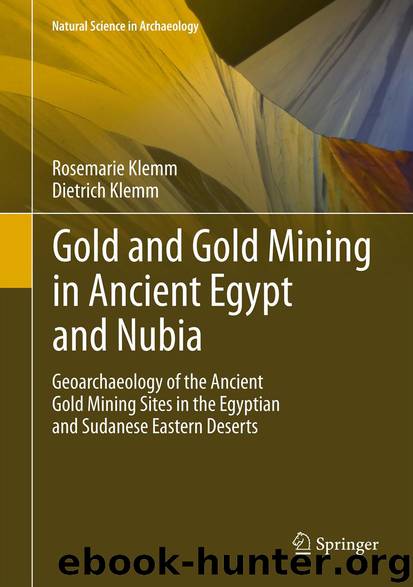Gold and Gold Mining in Ancient Egypt and Nubia by Rosemarie Klemm & Dietrich Klemm

Author:Rosemarie Klemm & Dietrich Klemm
Language: eng
Format: epub
Publisher: Springer Berlin Heidelberg, Berlin, Heidelberg
A diagonally running retention wall crossing the N-S oriented wadi is just barely made out in the stereoscopic aerial image, though hardly in the field. The wall served to collect water in a cistern, preserved in the form of a large hole to the N of the Hafir. When the cistern was full, the overspill flowed into the Hafir with its two, different-sized basins. One also recognises an inlet at the outside of the southern Hafir wall. Water was thus probably stored as follows: The northern basin and the cistern were filled with water derived by the retention wall of the main wadi, while the southern basin bordering on it was filled with rainwater from the side wadi through the inlet on the eastern side of the compound.
Occasional, still occurring floods today follow the same course as can be told by the sludge deposits inside and outside the compound. The size of the reservoir points to the enormous needs for water engendered by the wadiworkings. Indeed, almost all wadi courses in the district of Umm Garaiyat exhibit visible traces from intensive wadiworkings (Fig. 5.258).
Fig. 5.258Heaps from former wadiworkings at Umm Garaiyat
Download
This site does not store any files on its server. We only index and link to content provided by other sites. Please contact the content providers to delete copyright contents if any and email us, we'll remove relevant links or contents immediately.
The Lonely City by Olivia Laing(4120)
Animal Frequency by Melissa Alvarez(3755)
All Creatures Great and Small by James Herriot(3517)
Walking by Henry David Thoreau(3234)
Exit West by Mohsin Hamid(3184)
Origin Story: A Big History of Everything by David Christian(3139)
COSMOS by Carl Sagan(2950)
How to Read Water: Clues and Patterns from Puddles to the Sea (Natural Navigation) by Tristan Gooley(2855)
Hedgerow by John Wright(2777)
The Inner Life of Animals by Peter Wohlleben(2767)
Origin Story by David Christian(2684)
How to Read Nature by Tristan Gooley(2665)
Project Animal Farm: An Accidental Journey into the Secret World of Farming and the Truth About Our Food by Sonia Faruqi(2661)
How to Do Nothing by Jenny Odell(2645)
A Forest Journey by John Perlin(2588)
Water by Ian Miller(2584)
The Plant Messiah by Carlos Magdalena(2454)
A Wilder Time by William E. Glassley(2364)
Forests: A Very Short Introduction by Jaboury Ghazoul(2335)
